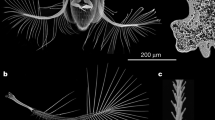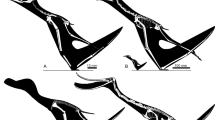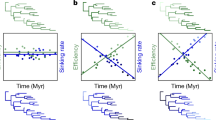Abstract
THE Cretaceous pterosaur Pteranodon was the largest flying animal known to exist in vertebrate history (see Fig. 1). Its wing-span reached 25 feet, far exceeding in size the largest modern bird, the albatross, which has a wing span of only 12 feet1,2. Although Pteranodon was so large, its weight was surprisingly low. This has been estimated as a maximum of 55 pounds or a minimum of 25 pounds1,3. About 40 pounds may be taken as a reasonable weight. In any case, Pteranodon was an animal of great size and fragility. Its weight had become reduced during the course of its evolution in many different ways; for example, the heavy hind legs and pelvic region of the earlier pterosaurs had been much reduced, the teeth had been lost, and the bone itself was no thicker than blotting-paper, the wing bones being strengthened internally by crosswise struts.
This is a preview of subscription content, access via your institution
Access options
Subscribe to this journal
Receive 51 print issues and online access
$199.00 per year
only $3.90 per issue
Buy this article
- Purchase on Springer Link
- Instant access to full article PDF
Prices may be subject to local taxes which are calculated during checkout
Similar content being viewed by others
References
Kripp, d. von, Nova Acta Leopoldina, 83, 217 (1943).
Landsborough-Thomson, Sir A., A New Dictionary of Birds, 43 (Nelson, London, 1964).
Brown, B., Bull. Amer. Mus. Nat. Hist., 52, 104 (1943).
Hankin, E. H., and Watson, D. M. S., Aeronaut. J., 18, 324 (1914).
Bellairs, d'A., Reptiles, 118 (Hutchinson, London, 1957).
Romer, A. S., Vertebrate Palaeontology, third ed., 146 (Univ. of Chicago Press, 1966).
Welch, A., Welch, L., and Irving, F., New Soaring Pilot, 34 (Murray, London, 1968).
Simkiss, K., Bird Flight, 79 (Hutchinson, London, 1963).
Halstead, L. B., The Pattern of Vertebrate Evolution, 140 (Oliver and Boyd, Edinburgh, 1969).
Author information
Authors and Affiliations
Rights and permissions
About this article
Cite this article
BRAMWELL, C., WHITFIELD, G. Flying Speed of the Largest Aerial Vertebrate. Nature 225, 660–661 (1970). https://doi.org/10.1038/225660a0
Received:
Issue Date:
DOI: https://doi.org/10.1038/225660a0
This article is cited by
-
Flying Ability of Archaeopteryx
Nature (1971)
-
Quantitative Assessment of the Flight of Archaeopteryx
Nature (1970)
Comments
By submitting a comment you agree to abide by our Terms and Community Guidelines. If you find something abusive or that does not comply with our terms or guidelines please flag it as inappropriate.



